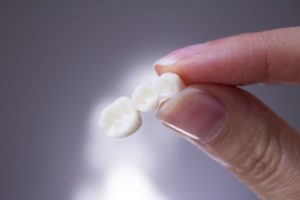Prevention is a crucial part of maintaining excellent oral health. We can provide the vital support your teeth need.
What to Do (and Not Do) If Your Dental Bridge Comes Out
August 4, 2023

Since you got your dental bridge placed years ago, you probably haven’t given it a ton of thought. It completes your smile seamlessly—until one day, it comes out. What should you do? How should you handle this scenario? Your choices matter! Here are some dos and don’ts to keep in mind in this type of situation.
Do: Call Your Dentist Right Away
In a dental emergency, it can be all too easy to panic, especially if your bridge is in a prominent location in your mouth, like your front teeth. Take a deep breath and call your dentist. Do not wait too long to make this call—the longer you put off fixing the problem, the harder it will become.
There are multiple possibilities to explain why your bridge came out, and your dentist can identify the cause and successfully meet your needs for a more permanent, lasting solution.
Don’t: Eat with That Area of Your Mouth
Depending on when your bridge comes out, you may need to eat a meal without it. In this situation, avoid biting or chewing in this area of your mouth, not just because you’ll have a gap in your teeth but also because your abutment teeth will be weaker and more vulnerable to decay than usual.
Do: Protect Your Abutment Teeth and Gap
While the bridge isn’t seated properly, your abutment teeth and the gap in between them are exposed to bacteria. To guard these teeth, you may temporarily cover the abutment teeth with sugar-free gum.
Don’t: Glue the Bridge Back On
Perhaps you think you can fix the bridge yourself. In your mind, using superglue or another adhesive may make sense. Do not do this! These products are not intended for oral use. To temporarily attach the bridge, you may place a small dab of toothpaste on your abutment teeth and put the restoration over them.
Do: Remember to Bring Your Bridge to Your Appointment
Your dentist will want to look at your abutment teeth as well as your bridge to determine why it came out in the first place. For instance, if your bridge has caused an uneven bite, it can be slightly altered to fit correctly. Or, if one of the teeth has a cavity, it can most likely be treated before the bridge goes back on it.
In many cases, unless the abutment teeth have been damaged or are too weak, the bridge can be reattached. If, however, these teeth aren’t strong enough to hold the bridge, you will need to consider other tooth replacement options.
If your bridge comes out prematurely, your quick, smart actions can get your smile back on track.
About the Author
Dr. Peter J. Colosimo is proud to have learned from his father, who opened the practice in 1971, the importance of compassionate, customized care. He attended Marquette University School of Dentistry where he graduated cum laude. At Shorewood Family Dentistry, he offers various restorative and emergency solutions ranging from fillings to crowns, from dental bridges to dentures. To learn more about our practice, you may contact us online or call us at (414) 332-8150.














